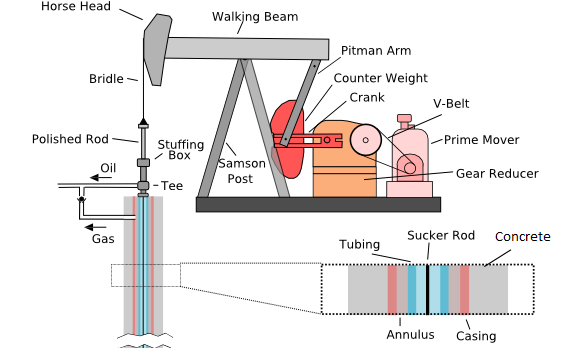Well casing
A well casing is a lining that is installed in an oil well once it is drilled and surrounds the well entirely. Casing is typically hollow steel pipe that lines the inside of the wellbore.[1] Casings are used to support the well, as the raw sides of the well would collapse in without support.[2]

In addition to providing support, the casing also isolates the contents of the well from the surrounding rock and soil. This prevents a loss of product and prevents contamination of surrounding rock and groundwater. It is the concrete component - a mix of cement, sand, and aggregate mixed with water - of the casing that provides the most protection against leakage.[2] The contamination of groundwater is a concern when drilling either for natural gas or petroleum. Additionally, casing is used to transport fluids back out of the well from well treatment.
Casing a Well
The well casing is constructed in multiple sections. Each length of casing is referred to as a casing string.[1] The interior of the casing is composed of steel and is smaller than the diameter of the well. The casing of the well is accomplished in phases, beginning with the largest diameter casing and ending with the smallest. Each section of the casing is connected by a collar or coupling.[2] The exterior of the casing is made of concrete.[2] It is poured into the gap between the well and steel casing once it has been inserted. This creates another barrier layer and prevents the interior casing from shifting.
The thickness of the casing varies depending on depth, with the casing being thicker near the top of the well where it is surrounded by soil and permeable rock that would easily transport contaminants if they were released. Near the bottom of the well, the casing is thinner as it is surrounded by solid, more impermeable rock that wouldn't transport contaminants as easily.
Capping a Well
Oil wells can be abandoned when they no longer produce enough oil or natural gas to be economically feasible. In this case, the well must be closed off properly to ensure that they do not pose a risk to the environment if abandoned. The process of closing off a well that is to be abandoned is known as capping the well. The first step in capping the well involves cleaning the wellbore of any oil or gas that could corrode the inside of the casing and reduce the effectiveness of any of the layers that prevent leakage. Any deficiencies identified in the casing itself must be repaired to ensure a tight seal. The well is then filled with water and other noncorrosive fluids. Once the inside of the well is prepared for abandonment, the well is cut and capped. In this process, the casing is cut one metre below the surface and a cap is placed on top of the well casing.[4]
References
- ↑ 1.0 1.1 FracFocus. (October 18, 2015). Well Casing [Online]. Available: http://fracfocus.org/hydraulic-fracturing-how-it-works/casing
- ↑ 2.0 2.1 2.2 2.3 Rigzone. (October 18, 2015). Well Casing [Online]. Available: http://www.rigzone.com/training/insight.asp?insight_id=333&c_id=24
- ↑ Wikimedia Commons. (October 18, 2015). Pump Jack [Online]. Available: https://upload.wikimedia.org/wikipedia/commons/3/3f/Pump_Jack_labelled.png
- ↑ Alberta Energy Regulator. (November 2, 2015). Why are Wells Abandoned [Online]. Available: https://www.aer.ca/abandonment-and-reclamation/why-are-wells-abandoned

